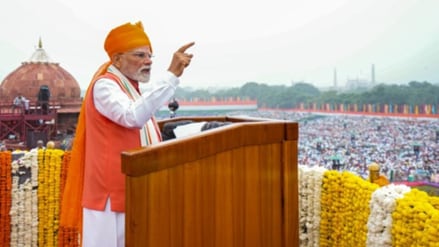By Soham Das
On Independence Day, from the Red Fort, the Prime Minister called on India to deepen atmanirbharta (self-reliance). The appeal came just days after Washington hit Indian exports with 50% tariffs and publicly brushed aside New Delhi’s bid for a negotiated truce. It is a stirring call, but also a familiar reflex: when faced with an economic crisis, India has turned inward, seeking safety in self-sufficiency. History suggests that path comes at a steep cost.
The limits of self-reliance
Yet history shows that two roads lie before us. One leads to openness—absorbing global capital, ideas, and markets—the other to insulation, where we produce for ourselves, in our own way, and on our own terms. We have walked the second path before, and the results have been sobering.
The 1905 Swadeshi and Boycott Movement is the clearest case. Indian private industry and services had been expanding exponentially since 1881, and as Tirthankar Roy’s A Business History of India shows, the movement left no visible trace on retail output from 1821 to 1941.
A roadmap for integration
There are aspects of modern economies we must absorb.
First, a firm is not just an assemblage of labour, capital, and materials. It is held together by “knowledge”—the invisible craft of complex contracting, deciphering demand, and perfecting processes. Two paths lead to mastery: we tinker and learn, or we observe and internalise. The best firms do both, collaborating with global peers and adapting know-how to local terrain. Self-reliance walls them off from global knowledge systems, crimping productivity over time.
Second, firms cut their coordination costs through long-term contracts and embedded knowledge flows—not through daily isolated transactions in the marketplace. Picture the difference between keeping an employee on payroll and hiring for a single day. A localisation drive forces a firm to tear up these arrangements. Aldaba (2012) demonstrates: as trade openness wanes, so does productivity. A statistic: Of the $5.6 trillion in exports produced through global value chains, Indian firms account for just 0.5%; China 17.5%.
Lastly, “make local” policies saddle businesses with a second objective—“indigenisation”—alongside profit maximisation. When the two collide, firms turn to the political economy for resolution. Over time, firms lean on the state apparatus to shut off market access to foreign firms and disadvantage competitor interests. Plouffe (2017) showed lobbying is much like production costs. Less productive firms compensate for their condition by calling for trade protection.
Our Make in India policy draws power from nationalism and anti-colonial memories. Yet, intellectually, it is an incomplete theory of the world. Global finance and supply chains allow firms to cross borders, locating their factories closest to the sources of demand. But when an Indian automaker opens a factory in South Africa, it violates the principles of Make in India as surely as when a foreign automaker repatriates profits from its factory in Tamil Nadu.
Worldwide, well-meaning localisation drives have ended up straining local MNCs. To champion indigenisation is to believe in an insular India—whose firms don’t engage meaningfully with the world and a nation unwilling to shape it. This yearning springs from a desire to imitate the success of others, but with a flawed grasp of the underlying dynamics. The result is incoherence: we welcome foreign direct investment, but only tolerate foreign portfolio investment, and while we seek market access abroad we deny equal treatment to foreign firms at home. To open up an economy is to integrate with the world’s flow of capital, labour, and goods tightly. To be a “conduit”, not a reservoir of this flow. To breathe in, we have to be willing to breathe out. Swadeshi economics violates these key principles.
For India, the path out of this policy impasse is to jettison the localisation push and instead aim to raise productivity across the economy. That begins with knowledge producers. Reform education, especially at the top, and reintroduce the profit motive. Open academic research labs to global investment to feed knowledge-building. Mashelkar, Shah, and Thomas (2024) outline a clear path to spur innovation by using government procurement to drive R&D demand. Experiment with large, city-sized special economic zones fully wired into global supply, labour, and capital networks. And open the last frontier—agriculture—to foreign capital, firms, and processes.
The intellectual roots of swadeshi trace to Dadabhai Naoroji’s Poverty and Un-British Rule in India, with its denunciation of foreign capital and trade. Lost to history is his contemporary Mancherjee Bhownagree, who opposed Naoroji and defended global businesses. Time has proved Bhownagree right.
As another Independence Day passes, we stand once more in the shadow of unfair trade terms. In the past, weakness at the negotiating table has driven us inward—insular, isolated, and poorer for it. We cannot afford that reflex again. History points to the other road: not insulation, but integration. Globalisation is not a shadow from the past; it is the stage for India’s ambitions.
The writer is CFA sector head–quantitative services, CRISIL.
Disclaimer: Views expressed are personal and do not reflect the official position or policy of FinancialExpress.com. Reproducing this content without permission is prohibited.
